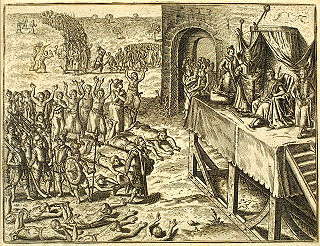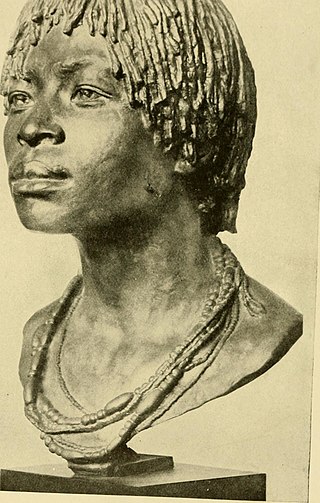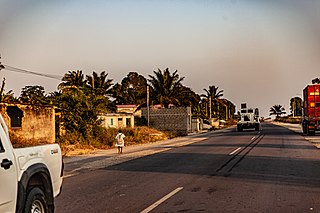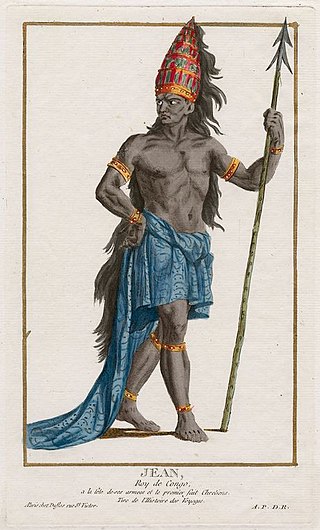Sources
- John K. Thornton. History of West Central Africa to 1850.Cambridge University Press. 2020. p. 206.
Nsonso was a kingdom in what is now Angola. It was taken over by the Kingdom of Kongo at some point in the 16th-century, but became de facto independent by the end of the 17th-century.
In 1699 a visitor wrote that Nsonso was larger than the Kingdom of Kongo at the time.

Congo may refer to the Congo River in central Africa or the Congo Basin, the sedimentary basin of the river.

The Manikongo, or Mwene Kongo, was the title of the ruler of the Kingdom of Kongo, a kingdom that existed from the 14th to the 19th centuries and consisted of land in present-day Angola, Gabon, the Republic of the Congo and the Democratic Republic of the Congo. The manikongo's seat of power was Mbanza Kongo, now the capital of Zaire Province in Angola. The manikongo appointed governors for the provinces of the Kingdom and received tribute from neighbouring subjects.

The Kongo people are a Bantu ethnic group primarily defined as the speakers of Kikongo. Subgroups include the Beembe, Bwende, Vili, Sundi, Yombe, Dondo, Lari, and others.

Battle of Mbwila was a battle that occurred on 29 October 1665 in which Portuguese forces defeated the forces of the Kingdom of Kongo and decapitated king António I of Kongo, also called Nvita a Nkanga.

The Kingdom of Kongo was a kingdom in Central Africa. It was located in present-day northern Angola, the western portion of the Democratic Republic of the Congo, and the Republic of the Congo. At its greatest extent it reached from the Atlantic Ocean in the west to the Kwango River in the east, and from the Congo River in the north to the Kwanza River in the south. The kingdom consisted of several core provinces ruled by the Manikongo, the Portuguese version of the Kongo title Mwene Kongo, meaning "lord or ruler of the Kongo kingdom", but its sphere of influence extended to neighboring kingdoms, such as Ngoyo, Kakongo, Loango, Ndongo, and Matamba, the latter two located in what is Angola today.

Soyo is a city, with a population of 200,920, and a municipality, with a population of 227,175, located in the province of Zaire in Angola, at the mouth of the Congo river. Soyo recently became the largest oil-producing region in the country, with an estimate of 1,200,000 barrels per day (190,000 m3/d).

The Bemba belong to a large group of Bantu peoples mainly in the Northern, Luapula, Muchinga, and the northern Central Province of Zambia. The Bemba entered modern-day Zambia before 1740 by crossing the Luapula River from Kola. A few other ethnic groups in the Northern and Luapula regions of Zambia speak languages that are similar to Bemba but do not share a similar origin. The Bemba people are not indigenous to the Copperbelt Province, having reached there only in the 1930s due to employment opportunities in copper mining.

Kakongo was a small kingdom located on the Atlantic coast of Central Africa, in the modern-day Republic of the Congo and Cabinda Province, Angola. Along with its neighboring kingdoms of Ngoyo and Loango, Kakongo became an important political commercial center during the 17th through 19th centuries. The people speak a dialect of the Kikongo language and thus may be considered a part of the Bakongo ethnicity. Kakongo was a vassal of the Kingdom of Kongo for a part of its history.

Álvaro II Nimi a Nkanga was king of Kongo from 1587 to 1614. He was one of Kongo's most powerful and important kings, who succeeded his father Álvaro I, but not until resolving a dispute with his brother. Both sides brought armies to M'banza-Kongo but to avoid bloodshed they agreed to single combat, won by Álvaro.

The Kinlaza were members of the Nlaza kanda or House of Kinlaza, one of the ruling houses of the Kingdom of Kongo during the 17th century. It was one of the main factions during the Kongo Civil War along with the Kimpanzu and Kinkanga a Mvika kandas. They are remembered in tradition and are evoked in a proverb, still current in the 1920s Nkutama a mvila za makanda "Kinkanga, Kimpanzu ye Kinlaza makukwa matatu malambila Kongo".

Mvemba a Nzinga, Nzinga Mbemba, Funsu Nzinga Mvemba or Dom Alfonso, also known as King Afonso I, was the sixth ruler of the Kingdom of Kongo from the Lukeni kanda dynasty and ruled in the first half of the 16th century. He reigned over the Kongo Empire from 1509 to late 1542 or 1543.
Lukeni lua Nimi was the traditional founder of the Lukeni kanda dynasty, first king of Kongo and founder of the Kingdom of Kongo Dia Ntotila. The name Nimi a Lukeni appeared in later oral traditions and some modern historians, notably Jean Cuvelier, popularized it. He conquered the kingdom of Mwene.

Nzinga-a-Nkuwu João I was the 5th ManiKongo of the Kingdom of Kongo between 1470 and 1509. He voluntarily converted to Roman Catholicism. He was baptized on 3 May 1491 and took the Christian name of João. Soon after, ManiKongo Nzinga-a-Nkuwu João I abandoned the new faith for a number of reasons, one of them being the Roman Catholic Church's requirement of monogamy. Politically, he could not afford to abandon polygamy and embrace monogamy, a cultural shift that the king could not contemplate as power in Kongo was elective, rather than hereditary as in Europe; as Kongo culture followed a matrilineality structure, where the elder son of the king is not automatically the next king.
The Kongo Civil War (1665–1709) was a war of succession between rival houses of the Kingdom of Kongo. The war waged throughout the middle of the 17th and 18th centuries pitting partisans of the House of Kinlaza against the House of Kimpanzu. Numerous other factions entered the fray claiming descent from one or both of the main parties such as the Água Rosada of Kibangu and the da Silva of Soyo. By the end of the war, Kongo's vaunted capital had been destroyed and many Bakongo were sold into the Trans-Atlantic Slave Trade.
Nkuwu a Ntinu was the fourth manikongo from the Lukeni kanda dynasty to rule the Kingdom of Kongo and reigned during the mid 15th century between c. 1450 and c. 1470.
Nlaza of Kongo was a manikongo from the Lukeni kanda dynasty and the 3rd ruler of the Central African kingdom of Kongo in the early 15th century. Little is known about him or his reign other than he was one of two cousins of Kongo's founder, Lukeni lua Nimi.

Bernardo I of Kongo was a 16th-century manikongo (ruler) of the Kingdom of Kongo, a region encompassing areas in 21st-century Angola and the Democratic Republic of Congo. He came to power after murdering his half-brother Afonso II who was less well-disposed toward the Portuguese.

The Kilukeni were members of the Lukeni kanda or House of Kilukeni, the ruling dynasty of the Kingdom of Kongo from its inception in the late 14th century until the 1567 with the rise of the House of Kwilu. The Kilukeni were springboard for most of the major factions that battled for control of Kongo during its civil war.

M'banza-Kongo, is the capital of Angola's northwestern Zaire Province with a population of 148,000 in 2014. M'banza Kongo was the capital of the Kingdom of Kongo since its foundation before the arrival of the Portuguese in 1483 until the abolition of the kingdom in 1915, aside from a brief period of abandonment during civil wars in the 17th century. In 2017, M'banza Kongo was declared a UNESCO World Heritage Site.